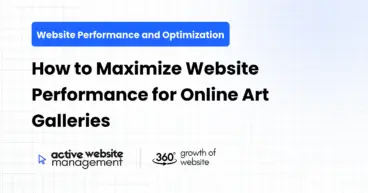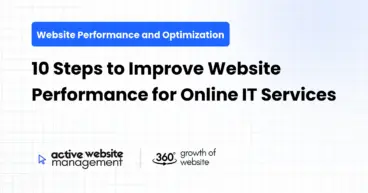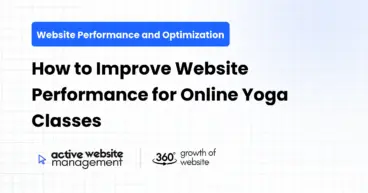December 26, 2024
8 min read
WordPress powers a significant portion of websites on the internet today. With its user-friendly interface and extensive customization options, it is a popular choice for both beginners and experienced developers. However, as websites grow in content, traffic, and complexity, performance can start to suffer. Slow websites can lead to high bounce rates, poor user experiences, and a drop in search engine rankings.
This article will dive deep into the common WordPress performance bottlenecks, providing you with practical solutions to ensure your website runs as fast as possible. If you’re looking to enhance your website’s speed, this guide will cover everything you need, from optimizing plugins to improving server performance.
In the digital world, website performance is a critical factor for success. Research shows that even a 1-second delay in page load time can result in a 7% decrease in conversions and a 16% decrease in customer satisfaction. Search engines like Google also prioritize speed, making it one of the ranking factors in search algorithms.
For WordPress users, improving website performance is crucial not only to keep users engaged but also to maintain high search engine rankings and enhance the user experience. In this article, we’ll look at the most common WordPress performance bottlenecks and how to fix them to ensure your website is running at its full potential.
2.1 Heavy or Unoptimized Images
One of the most significant performance bottlenecks on WordPress websites is heavy or unoptimized images. High-quality images are essential for a visually appealing website, but large image files can dramatically slow down page load times, especially for mobile users.
Problem: Images that aren’t compressed or appropriately sized consume more bandwidth and take longer to load.
Solution:
- Use Image Compression Tools: Plugins like Smush or ShortPixel can automatically compress images without sacrificing quality.
- Responsive Images: Ensure images are responsive so they load in the appropriate size depending on the user’s device.
- WebP Format: Use modern image formats like WebP, which provide high-quality images at smaller file sizes.
Don’t Just Maintain Your Website—
Grow It using Active Website Management! Don't Wait for Growth—Accelerate It with Active Website Management
2.2 Too Many HTTP Requests
Every time a browser needs to load a page, it sends requests to the server for various resources such as CSS files, JavaScript, and images. When your website has too many resources to load, it increases the page load time.
Problem: Each HTTP request adds overhead, slowing down the page rendering process.
Solution:
- Minify CSS and JavaScript Files: Use plugins like Autoptimize or WP Rocket to minify and combine CSS and JavaScript files, reducing the number of HTTP requests.
- Lazy Loading for Images: Implement lazy loading for images and videos, which delays loading content until it is needed. WordPress 5.5 and later includes built-in lazy loading for images.
- Use a Content Delivery Network (CDN): A CDN stores copies of your website in different locations globally, serving content from the nearest server, reducing the time it takes to send requests.
2.3 Slow Database Queries
WordPress websites rely on databases to store content, settings, and configurations. Over time, your WordPress database can accumulate redundant data, causing slow queries that impact overall site performance.
Problem: Complex or inefficient database queries can result in slower page loads.
Solution:
- Optimize Your Database: Use plugins like WP-Optimize or WP-Sweep to clean up unnecessary data such as post revisions, drafts, and spam comments.
- Use Object Caching: Consider using Redis or Memcached for object caching, which stores frequently used data in memory, reducing the need for repetitive database queries.
- Database Indexing: Ensure your database is properly indexed to speed up queries. You can use tools like phpMyAdmin to review and optimize your WordPress database.
2.4 Excessive Use of Plugins
Plugins are essential for adding functionality to your WordPress site, but they can also slow down your website if overused or poorly coded.
Problem: Too many plugins can add excessive scripts, styles, and database queries, resulting in a performance hit.
Solution:
- Limit Plugins: Use only essential plugins and deactivate or delete any plugins you are no longer using.
- Choose Lightweight Plugins: Look for well-coded, performance-optimized plugins. For example, Yoast SEO or RankMath are SEO plugins that are feature-rich but don’t negatively impact performance.
- Perform Regular Audits: Regularly audit your installed plugins for performance issues. You can use tools like Query Monitor to identify plugins that are causing slow queries.
2.5 Outdated Themes and Plugins
Running outdated themes and plugins is not only a security risk but can also impact the performance of your website. Outdated code may not be optimized for modern browsers and could contain bugs that slow down your site.
Problem: Outdated themes or plugins may have unoptimized code, causing conflicts or slow performance.
Solution:
- Keep Everything Updated: Always ensure your WordPress core, themes, and plugins are up to date. Enable automatic updates where possible.
- Use a Lightweight Theme: Choose themes that are optimized for speed. Themes like GeneratePress or Astra are known for being lightweight and fast.
- Update Plugins Regularly: Regularly check for updates and install them. If a plugin is no longer being maintained, consider finding an alternative.
3.1 Image Optimization Techniques
Optimizing images is one of the most effective ways to speed up your WordPress website. Use a combination of compression, responsive images, and modern image formats to ensure faster loading times.
- Image Compression Tools: Use plugins like Smush or EWWW Image Optimizer to automatically compress and resize images upon upload.
- Image Sizing: Ensure your images are not larger than they need to be. For example, use a 1500px width image for a full-width header rather than an oversized 5000px image.
- WebP Format: Consider converting your images to WebP, a modern image format that offers high-quality compression.
3.2 Minimizing HTTP Requests
Reducing the number of HTTP requests made by the browser is essential for faster load times. By minifying files, combining resources, and using a CDN, you can significantly decrease load times.
- Minification: Tools like Autoptimize and WP Rocket allow you to minify CSS, JavaScript, and HTML, reducing the size of these files and improving loading speed.
- Combining Files: Instead of having multiple CSS and JavaScript files, combine them into one file to reduce the number of requests.
- CDN Integration: Set up a CDN service like Cloudflare or KeyCDN to deliver static content from a network of servers closest to your visitors.
3.3 Database Optimization
Your website’s database can become bloated over time with unnecessary data. Regular database optimization can prevent this and keep your site running smoothly.
- Regular Cleanup: Use tools like WP-Optimize to regularly clean up your database, removing unnecessary data like post revisions, drafts, and spam comments.
- Optimize Database Tables: Use phpMyAdmin to optimize your database tables, which can improve query performance.
- Caching Solutions: Implement database caching with tools like Redis or Memcached to reduce the load on your database server.
3.4 Plugin Management
Plugins are necessary but can negatively affect performance if not managed properly. Regularly review your plugins and deactivate those you no longer need.
- Audit Your Plugins: Use the Query Monitor plugin to identify plugins causing slow database queries. Uninstall any plugins that are not necessary.
- Selective Plugin Usage: Instead of using multiple plugins for similar functions, try to combine them into a single plugin to reduce the load.
Don't Wait for Growth—Accelerate It with
Active Website Management Don't Wait for Growth—Accelerate It with Active Website Management
3.5 Caching Strategies
Caching is an effective way to reduce load times by storing copies of your site’s pages, reducing the need for repeated server processing.
- Page Caching: Use caching plugins like WP Rocket, W3 Total Cache, or LiteSpeed Cache to cache static versions of your pages.
- Browser Caching: Configure browser caching to store static files in visitors’ browsers, reducing the need to download them on subsequent visits.
4. Best Practices for Maintaining WordPress Website Performance
4.1 Active Website Management(AWM)
AWM is Consistent monitoring and management of your WordPress website are crucial for maintaining performance. This involves regular audits, optimization, and security checks to ensure your site runs at peak efficiency.
- Monitor Website Speed: Use tools like GTmetrix or Pingdom to regularly test your site’s load time and identify any issues.
- Database Maintenance: Schedule regular database cleanups to remove outdated data and optimize queries.
- Content Delivery Network (CDN): Integrate a CDN like Cloudflare to reduce latency and speed up your site.
4.2 Regular Updates and Security
Updating your WordPress core, themes, and plugins is essential to keep your website running efficiently and securely. Updates often include performance improvements and bug fixes.
- Enable Automatic Updates: Configure WordPress to automatically update minor releases and security patches.
- Use Reliable Plugins and Themes: Stick to trusted and well-supported plugins and themes that are optimized for speed.
5. Conclusion: Keeping Your Website Fast and Efficient
WordPress performance bottlenecks can significantly impact the speed and user experience of your site. By identifying the common issues such as unoptimized images, excessive plugins, and slow database queries, you can take proactive steps to improve performance. Regular maintenance, caching, and using the right tools will keep your WordPress website running smoothly.
With these solutions, you can ensure your website remains fast, efficient, and capable of handling increasing traffic without sacrificing user experience.
By implementing these techniques, you’ll be able to keep your WordPress website running like a well-oiled machine for years to come!






